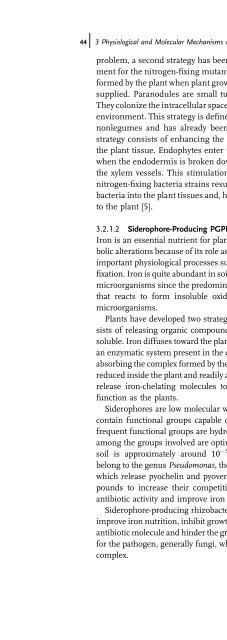Page 2 Plant-Bacteria Interactions Edited by Iqbal Ahmad, John ...
Page 2 Plant-Bacteria Interactions Edited by Iqbal Ahmad, John ...
Page 2 Plant-Bacteria Interactions Edited by Iqbal Ahmad, John ...
You also want an ePaper? Increase the reach of your titles
YUMPU automatically turns print PDFs into web optimized ePapers that Google loves.
44j 3 Physiological and Molecular Mechanisms of <strong>Plant</strong> Growth Promoting Rhizobacteria (PGPR)<br />
problem, a second strategy has been developed: the creation of a special environment<br />
for the nitrogen-fixing mutants called paranodules. These structures can be<br />
formed <strong>by</strong> the plant when plant growth regulators, either synthetic or bacterial, are<br />
supplied. Paranodules are small tumors that nitrogen-fixing bacteria penetrate.<br />
They colonize the intracellular spaces and fix nitrogen for the plant in a competitive<br />
environment. This strategy is defined as a formation of nitrogen-fixing nodules in<br />
nonlegumes and has already been assayed in corn and wheat [15]. The third<br />
strategy consists of enhancing the penetration of nitrogen-fixing endophytes on<br />
the plant tissue. Endophytes enter the plant upon the emergence of lateral roots<br />
when the endodermis is broken down, allowing penetration <strong>by</strong> the bacteria up to<br />
the xylem vessels. This stimulation of root branching owing to the presence of<br />
nitrogen-fixing bacteria strains results in enhanced penetration of nitrogen-fixing<br />
bacteria into the plant tissues and, hence, in an increase of fixed nitrogen available<br />
to the plant [5].<br />
3.2.1.2 Siderophore-Producing PGPR<br />
Iron is an essential nutrient for plants. Iron deficiency is exhibited in severe metabolic<br />
alterations because of its role as a cofactor in a number of enzymes essential to<br />
important physiological processes such as respiration, photosynthesis and nitrogen<br />
fixation. Iron is quite abundant in soils but is frequently unavailable for plants or soil<br />
microorganisms since the predominant chemical species is Fe 3þ , the oxidized form<br />
that reacts to form insoluble oxides and hydroxides inaccessible to plants or<br />
microorganisms.<br />
<strong>Plant</strong>s have developed two strategies for efficient iron absorption. The first consists<br />
of releasing organic compounds capable of chelating iron, thus rendering it<br />
soluble. Iron diffuses toward the plant where it is reduced and absorbed <strong>by</strong> means of<br />
an enzymatic system present in the cell membrane. The second strategy consists of<br />
absorbing the complex formed <strong>by</strong> the organic compound and Fe 3þ , where the iron is<br />
reduced inside the plant and readily absorbed. Some rhizosphere bacteria are able to<br />
release iron-chelating molecules to the rhizosphere and hence serve the same<br />
function as the plants.<br />
Siderophores are low molecular weight compounds, usually below 1 kDa, which<br />
contain functional groups capable of binding iron in a reversible way. The most<br />
frequent functional groups are hydroximates and catechols, in which the distances<br />
among the groups involved are optimal to bind iron. Siderophore concentration in<br />
soil is approximately around 10 30 M. Siderophore-producing bacteria usually<br />
belong to the genus Pseudomonas, the most common being Pseudomonas fluorescens,<br />
which release pyochelin and pyoverdine. Rhizosphere bacteria release these compounds<br />
to increase their competitive potential, since these substances have an<br />
antibiotic activity and improve iron nutrition for the plant [27].<br />
Siderophore-producing rhizobacteria improve plant health at various levels: they<br />
improve iron nutrition, inhibit growth of other microorganisms with release of their<br />
antibiotic molecule and hinder the growth of pathogens <strong>by</strong> limiting the iron available<br />
for the pathogen, generally fungi, which are unable to absorb the iron–siderophore<br />
complex.
















